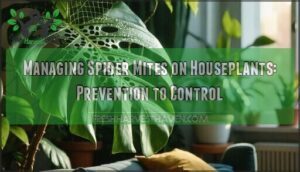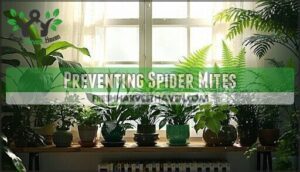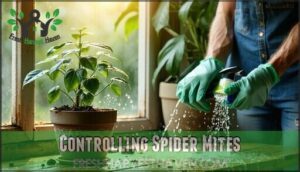This site is supported by our readers. We may earn a commission, at no cost to you, if you purchase through links.

These microscopic pests reproduce at alarming speed, with females laying up to 100 eggs that hatch in just days. Left unchecked, a handful of mites becomes thousands within weeks, draining the life from your houseplants one puncture wound at a time.
The good news: catching an infestation early and applying the right combination of prevention and control methods can save even heavily damaged plants and protect the rest of your collection from these persistent invaders.
Table Of Contents
- Key Takeaways
- Spider Mite Biology
- Identifying Infestations
- Preventing Spider Mites
- Controlling Spider Mites
- Managing Spider Mite Infestations
- Frequently Asked Questions (FAQs)
- Can I reuse soil that has spider mites?
- Can spider mites survive winter indoors?
- Do spider mites spread between plants?
- How long does treatment take?
- Are spider mites harmful to humans?
- What plants resist spider mites naturally?
- Can spider mites spread to nearby furniture?
- How long do spider mites survive off plants?
- Are certain houseplant species more susceptible to mites?
- Can spider mites develop resistance to treatments?
- Conclusion
Key Takeaways
- Spider mites reproduce at lightning speed—completing their lifecycle in just 7-10 days under warm, dry conditions—which means a small problem can explode into thousands of pests within weeks if you don’t catch it early.
- Maintaining humidity above 50% and temperatures below 75°F creates an inhospitable environment that naturally discourages spider mite reproduction, making environmental control your strongest preventive weapon.
- Effective treatment requires persistence with multiple methods applied every 2-3 days for 1-2 weeks, rotating between soap sprays, horticultural oils, and water pressure to break the reproductive cycle and prevent resistance.
- Weekly inspections focusing on leaf undersides with a magnifying glass let you spot telltale signs like stippling, webbing, and eggs before populations explode, turning reactive crisis management into proactive plant protection.
Spider Mite Biology
You can’t fight what you can’t see. Spider mites thrive because they’re masters of disguise—microscopic pests that blend into your plants until damage appears.
Understanding their biology gives you the upper hand in stopping them before they spread.
Spider Mite Identification
Spider mites might be tiny troublemakers, but knowing what they look like is your first line of defense against these sap-sucking pests. These arachnids measure barely half a millimeter and sport eight legs—a dead giveaway they’re not insects. You’ll spot them in red, green, yellow, or brown, often with two dark spots.
Different mite species leave telltale web patterns and stippled feeding signs on leaves, while clusters of translucent eggs hide on undersides during leaf inspection.
Spider Mite Lifecycle
Once you know what spider mites look like, the next step is understanding how fast they can take over—because their lifecycle moves at lightning speed. These arachnids complete their development in just 7-10 days under warm, dry conditions, which explains why a minor problem can become a full-blown infestation seemingly overnight.
Spider mites can explode from a minor issue to a full-blown infestation in just 7-10 days under warm, dry conditions
The twospotted spider mite progresses through distinct life cycle stages:
- Mite egg stage – Females deposit 50-100 translucent eggs on leaf undersides, hatching within 3-5 days at temperatures above 80°F.
- Larval phase – Six-legged larvae emerge and feed aggressively for 1-3 days.
- Nymphal stages – Two developmental phases with eight legs, each lasting 1-3 days.
- Adult stage – Mature females live up to 30 days, producing roughly 20 eggs daily.
- Population surge – This mite reproduction rate means colonies can double weekly in typical household conditions.
Understanding these developmental phases helps you time your control methods for maximum impact.
Environmental Factors
Understanding the lifecycle is half the battle—now let’s look at what actually triggers these pests to multiply. Temperature control plays a starring role: spider mites thrive when your home hits 75-85°F. Drop humidity levels below 50%, and you’ve rolled out the welcome mat.
Poor air circulation traps warm, stagnant air around leaves, while inconsistent watering and inadequate light exposure stress your plants. These environmental factors don’t just attract spider mites—they weaken your plants’ natural defenses, making them vulnerable.
Even soil quality matters, since nutrient-poor conditions compromise plant vigor. A quick water spray can temporarily boost humidity, but long-term environmental management is your real defense. Effective spider mite control requires understanding spider mite behavior to prevent infestations.
Identifying Infestations
Catching spider mites early makes all the difference between a quick fix and a full-blown battle. You’ll need to know what to look for—from the telltale webbing to the subtle leaf damage that signals trouble.
Here’s how to spot an infestation before it takes over your plants.
Visual Signs of Infestation
You’ll spot the first clues of a spider mite problem before you ever see the pest itself. Look for fine stippling—tiny yellow or white dots scattered across leaves where spider mites puncture cells. As the infestation grows, leaves develop bronze or gray discoloration signs.
During leaf inspection, check undersides for delicate webbing stretched between stems and leaf veins, often dusted with debris. You might also notice mite eggs clustered near these web patterns, signaling active reproduction.
Direct Observation Methods
When you need certainty rather than guesswork, these two hands-on techniques will reveal whether spider mites have taken up residence on your plants.
The white paper test is your first line of defense. Hold a sheet of white paper beneath suspect foliage and tap the leaves firmly. Watch for tiny specks crawling across the paper—that’s mite detection in action.
For microscope use or closer visual inspection, grab a hand lens or magnifying glass to examine leaf surfaces during your leaf inspection. You’ll spot the eight-legged arachnids clearly at 10x magnification. Focus your leaf examination on undersides where mites cluster.
These methods confirm infestation signs and enable accurate spider mite identification before damage spreads.
Common Infestation Signs
Spider mites leave distinctive calling cards that make detection straightforward once you know what to look for. These signs of spider mite infestation progress rapidly, so catching them early protects your plants from serious damage.
Watch for these telltale symptoms:
- Fine webbing stretched between leaves and stems, resembling delicate silk threads
- Leaf stippling appearing as countless pale dots where spider mites pierce plant cells
- Leaf discoloration shifting from healthy green to yellowed, bronzed, or bleached tones
- Plant discolor intensifying as the infestation spreads across multiple leaves
- Mite eggs clustered on leaf undersides, barely visible as tiny spheres
The webbing becomes more prominent as populations explode, sometimes coating entire branches in gossamer threads. Regular plant inspections can help identify common spider mites before infestations spread.
Preventing Spider Mites
The best defense against spider mites is stopping them before they start. A few smart habits can keep these pests from gaining a foothold on your houseplants.
Here are four proven prevention strategies that protect your indoor garden.
Inspect Plants Frequently
Catching spider mites early is like spotting a small fire before it burns down your house—one quick check each week can prevent months of plant recovery. Inspect your plants using a magnifying glass, focusing on leaf undersides where these pests hide. Look for infestation warning signs like fine webbing, tiny stippling, or yellowish specks.
These early detection methods work best when you examine both mature and new foliage systematically. If you spot trouble, neem oil can disrupt their reproduction before colonies explode. Make frequent monitoring part of your routine—it’s your best defense against these rapid breeders.
Increase Humidity Levels
Think of humidity as your invisible shield—spider mites hate moisture-rich air and thrive when conditions drop below 40%. Increasing humidity levels to 40–60% can cut infestation rates by up to three times compared to dry environments. Here’s how to create that protective Microclimate Creation around your plants:
- Humidifier Placement: Position a humidifier near your plant collection to maintain consistent moisture without over-saturating leaves.
- Capillary Mats: Use self-watering mats or reservoirs to sustain humidity for days while preventing root stress.
- Group plants together: This naturally elevates local humidity and discourages mite activity.
- Humidity Monitoring: Track levels weekly, especially during winter when indoor heating can drop humidity 20–30%.
- Strategic Isolation: Keep vulnerable thin-leaved tropicals away from heating vents and drafty windows where dry air accelerates reproduction.
Water Spray through Misting Techniques offers temporary relief but risks fungal problems if overused—stick with sustainable methods instead.
Use Neem Oil Preventively
Neem oil acts as your first line of defense against spider mites, functioning like a protective shield for your houseplants. This natural pesticide disrupts mite reproduction while creating an environment these pests can’t tolerate. The oil spray method coats leaf surfaces, suffocating existing mites and preventing new colonies from establishing.
Apply neem oil preventively using these three proven steps:
- Timing matters – Spray every 7-14 days during peak growing season, focusing on leaf undersides where spider mites congregate and feed.
- Mix it right – Combine 2 tablespoons neem oil per gallon of water with a drop of dish soap to help the mite repellent stick to foliage.
- Evening applications – Treat your houseplants after sunset to prevent leaf burn and optimize absorption overnight when temperatures drop.
Neem oil benefits extend beyond immediate pest control—regular use strengthens your preventive infestation strategy by making plants less attractive to spider mites. This preventive measure works best when combined with proper watering and adequate humidity levels.
Reduce Plant Stress
Healthy plants fight off spider mites like strong immune systems ward off illness—but when your houseplants are running on empty, these pests move in fast. Master water management by avoiding both drought and overwatering, which weakens plant health. Maintain nutrient balance through regular fertilization, ensuring soil quality supports vigorous growth.
Proper pruning techniques remove dead foliage where mites hide. Keep humidity levels consistent and adjust environmental factors like temperature and light exposure. These plant care tips strengthen your plants’ natural defenses, making spider mite invasions far less likely.
Controlling Spider Mites
Once you spot spider mites, it’s time to take action. The good news is you’ve got several effective methods to knock down their numbers and reclaim your plants. Here’s how to fight back.
Soap and Water Method
A simple spray bottle filled with soapy water can knock out spider mites faster than you’d think. Mix one teaspoon of mild liquid soap—not detergent—into a quart of lukewarm water for your soap solution.
Spray every leaf surface thoroughly, targeting undersides where spider mites hide. The gentle cleaning action suffocates mites on contact while water pressure dislodges eggs.
Let it sit for 30 minutes, then rinse to prevent leaf damage. Repeat every three days for effective mite removal and lasting pest control on your houseplants.
Horticulture Oils Treatment
If soap and water won’t cut it, horticultural oils pack a stronger punch that spider mites can’t survive. These oil-based solutions work by coating mites and eggs, blocking their respiratory systems completely.
Neem oil stands out among natural pesticides—its active compounds disrupt mite reproduction while acting as effective mite repellents. Mix your horticultural spray to 1-2% concentration, then coat leaf undersides where pests hide.
For stubborn infestations, alternate between insecticidal soap and neem oil effects for thorough pest control. Apply every 7-10 days until mites disappear.
Spray With Water Method
When soap and oils feel too heavy-handed, plain water becomes your simplest weapon against spider mites. This method relies on water pressure control to physically remove pests from houseplants without chemicals—perfect when you’re concerned about leaf sensitivity or just want straightforward pest control.
The technique works best with proper spray nozzle types and attention to water temperature effects. Here’s your action plan:
- Set up in your sink or shower – Position plants where runoff won’t create a mess and you can reach all angles comfortably.
- Use lukewarm water at moderate pressure – Cold water stresses plants while excessive force damages delicate foliage.
- Target leaf undersides thoroughly – Spider mites cluster where they’re protected, so direct your spray where it counts most.
- Repeat every 2-3 days for two weeks – This mite removal technique disrupts their lifecycle before new eggs hatch.
You’re getting foliar spray benefits beyond pest control—clean leaves photosynthesize better. For stubborn cases, alternate with neem oil between watering sessions.
Invite Predatory Mites
While water pressure works wonders for quick knockdown, predatory mite release offers long-term biological control methods that put nature to work. You’ll want to choose the right mite species selection for your situation. Phytoseiulus persimilis excels at devouring eggs and larvae, while Amblyseius swirskii targets adult two-spotted spider mites most effectively.
For houseplants, release 10 predatory mites per plant, adding 1-2 more per visibly infested leaf. These natural predators—true beneficial insects—consume up to 20 spider mites daily, establishing integrated pest management right in your living room.
Order them online and release promptly upon arrival. Keep humidity above 50% so these biological control agents thrive while hunting down your pest problem.
Managing Spider Mite Infestations
Once you’ve knocked back spider mites with your chosen treatment method, the real work begins—keeping them from making a comeback. Managing an infestation isn’t a one-and-done deal; it requires consistent attention and a few strategic habits.
Here’s how to stay on top of things and protect your plants long-term.
Isolate Infested Plants
Spider mites don’t wait for permission to spread — once they’ve claimed one plant, they’ll treat your entire collection like an all-you-can-eat buffet unless you act fast. Quarantine methods start with immediate plant isolation. Move infested houseplants to a separate room to establish mite migration barriers and prevent widespread damage.
Effective infestation containment requires:
- Placing quarantined plants at least 10 feet from healthy specimens
- Using insecticidal soap treatments during isolation
- Inspecting neighboring plants for early mite infestation signs
- Maintaining quarantine for 2-3 weeks minimum
This disease prevention strategy stops spider mites cold.
Clean Leaves Regularly
Most houseplant owners forget that dust isn’t just unsightly — it’s actually a welcome mat for spider mites looking to set up camp. Washing plant leaves weekly removes debris that harbors pests and blocks photosynthesis.
Use a damp cloth for smooth-leaved varieties or spray them gently in the sink. For fuzzy-leaved plants, a soft brush works wonders.
This simple plant hygiene routine lets you spot leaf discoloration early while improving humidity control naturally. Mix in neem oil or insecticidal soap during cleaning for double-duty mite removal that keeps your plant care proactive instead of reactive.
Adjust Environmental Conditions
Your indoor climate plays a surprisingly decisive role in whether spider mites thrive or struggle to survive. Strategic environmental control creates inhospitable conditions these pests can’t tolerate:
- Humidity management — Keep humidity levels above 50% using humidifiers or plant groupings
- Temperature control — Maintain temperatures below 75°F to slow reproduction cycles
- Air circulation — Position small fans to discourage webbing and reduce hotspots
Pair lighting adjustment with consistent soil moisture to prevent drought-stressed plants that attract infestations.
Monitor Plant Health
Regular monitoring isn’t just good practice—it’s the difference between catching a few mites and losing an entire plant collection. Schedule weekly Plant Inspection sessions where you examine leaf undersides with a magnifying glass—that’s where spider mites hide. Look for stippling, webbing, or pale dots during your Leaf Analysis.
Growth Tracking helps identify stressed plants before populations explode. This Health Monitoring approach turns Pest Detection Methods into routine habit, giving you control before infestations spiral out of hand.
Frequently Asked Questions (FAQs)
Can I reuse soil that has spider mites?
Picture dumping last season’s contaminated potting mix straight into your fiddle leaf fig—a rookie mistake that turned one gardener’s prize plant into a webbed wasteland within weeks.
You can reuse soil after treating it through soil sterilization via heat or adding beneficial microorganisms, eliminating mite residue and pest persistence—critical steps before soil replacement becomes necessary.
Can spider mites survive winter indoors?
Yes, spider mites survive winter indoors easily. Heated homes provide ideal conditions—temperatures between 75–85°F and low humidity—that support year-round reproduction. Cold tolerance isn’t necessary when indoor habitats mimic their preferred environment, making seasonal adaptation unnecessary and pest prevention critical.
Do spider mites spread between plants?
These pests move easily through plant proximity, mite migration via air currents, airborne transmission on clothing, and soil contamination from shared tools.
Immediate isolation is critical for spider mite control and pest prevention—houseplant care requires swift action to stop mite infestation from spreading colony-wide through human transfer.
How long does treatment take?
Effective Spider Mite Control takes persistence—these pests complete their lifecycle in just 7-10 days. Treatment Duration usually spans 1-2 weeks with applications every 2-3 days. You’ll need multiple rounds since eggs resist initial Neem Oil or soap sprays.
Breaking the Infestation Timeline requires consistency throughout the Healing Process.
Are spider mites harmful to humans?
Good news—these tiny pests won’t harm you. Spider mites pose no human health risks, don’t cause mite allergies or skin irritation, and have zero toxicity levels.
Focus your pest management efforts on plant protection using neem oil and proper houseplant care instead.
What plants resist spider mites naturally?
Thick, waxy leaves act like armor in indoor gardening—spider mites can’t penetrate the surface.
Succulents, African violets, and rosemary are hardy houseplants with natural defense mechanisms that create mite repellent conditions, making them resistant plant species with spider mite immunity for organic gardening and better plant health.
Can spider mites spread to nearby furniture?
Spider mites don’t establish themselves on furniture, but mite migration and cross-contamination can occur temporarily. These pests need living plant tissue to survive, making furniture safety less concerning than pest isolation and home hygiene around houseplants.
How long do spider mites survive off plants?
Think of them as uninvited guests who can’t survive long without a host. Spider mites usually last only a few days off plants—their survival rate drops quickly without food, though humidity levels can extend this mite starvation period slightly.
Are certain houseplant species more susceptible to mites?
Certain houseplants are more vulnerable than others. Spider mites favor indoor plants with thin leaves—like English ivy, fiddle-leaf figs, and spider plants.
Neem oil and proper plant care reduce susceptibility across all varieties.
Can spider mites develop resistance to treatments?
Like bacteria outsmarting antibiotics, spider mites can develop treatment resistance through repeated exposure to the same pesticide.
Rotating miticides and combining organic pest control methods prevents mite adaptation and maintains chemical efficacy for long-term resistance management.
Conclusion
An ounce of prevention truly beats a pound of cure when managing spider mites on houseplants. Regular monitoring catches problems before they escalate, while consistent humidity and preventive treatments keep populations from gaining a foothold.
When infestations do occur, combining multiple control methods—isolation, physical removal, horticultural treatments, and environmental adjustments—delivers the most reliable results. Your plants depend on your vigilance, and catching these near-invisible pests early makes all the difference between minor inconvenience and major plant loss.
- http://npic.orst.edu/pest/spidermite.html
- https://www.instagram.com/nathanheinrich/?hl=en
- https://verdivista.com/en/blog/994a197d-457e-4927-a863-9702bcacec44
- https://research.wur.nl/en/publications/are-low-humidity-levels-a-limiting-factor-for-spider-mite-control
- https://extension.oregonstate.edu/catalog/how-recognize-manage-spider-mites-home-garden









